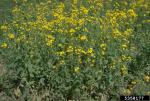BETHANY, Mo. – It’s spaghetti disguised as a vegetable. Spaghetti squash is a versatile, nutritious fall favorite that is often overlooked by shoppers who don’t know how to cook it, says University of Missouri Extension nutrition specialist Janet Hackert.
Grocery produce sections are filled with colorful winter squash such as spaghetti squash in the fall. Their yellow, thick, inedible skin makes a colorful fall table decoration, but squash are more than ornamental.
“The interesting thing about spaghetti squash is its texture,” Hackert says. “The seeds of this squash are removed like other winter squash. But when it is cooked, the pulp of spaghetti squash becomes stringy and similar to spaghetti strands. Its flavor is different though.”
As a pasta substitute, spaghetti squash’s textured strands provide a low-fat, low-calorie serving of flavorful fiber, Hackert says.
A half cup of cooked spaghetti squash has only 40 calories and 1 gram of fat. And you’ll get 3 grams of fiber, 9 grams of carbohydrates and 1 gram of protein. It also it contains some vitamin C, potassium and vitamin A.
Harvest or buy squash when it “feels heavy for its size,” according to MU Extension’s free Seasonal and Simple app, available at http://seasonalandsimple.info. The skin should be intact and hard. Choose a squash with a dull skin, as shiny skin indicates the squash is not ripe. Store in a single layer in a cool, dry place for up to two months.
Squash is a versatile performer in the kitchen. Bake it in the oven or microwave, boil it or cook in a slow cooker.
All winter squash bake well. Cut the squash in two parts, using a heavy-duty sharp knife, scoop out seeds and brush the cut surface with oil. Place the cut side down in a baking dish with ¼ cup water. Bake uncovered at 350 degrees until the flesh is soft. Once baked, the skin can be peeled away from the flesh and discarded. With spaghetti squash, peel the pulp away and use a fork to break into pasta-like strands.
Don’t can squash, but you can freeze it. Cook, then remove its pulp from the rind and place in freezer containers. Place these in cold water until cool. Store in quantities ready to serve or for use in recipes. Add a little extra to make up for moisture lost during baking or cooking. For details, see MU Extension publication GH1503, “Quality for Keeps: Freezing Vegetables,” available for free download at http://extension.missouri.edu/p/gh1503.
Butternut and acorn squash are common in Missouri. With dark yellow or orange color, these two offer even more vitamin A than spaghetti squash. Recipes, including Spaghetti Squash with Parmesan Cheese, Acorn Squash with Brown Sugar, Butternut Squash and Apple Bake, and Wonderful Winter Squash, can be found in the Seasonal and Simple app.
MU Extension nutrition specialist Tammy Roberts gives more tips in the article “How to Prepare Spaghetti Squash” at http://missourifamilies.org/nutrition/recipes/SpaghettiSquash.htm.
You’ll also find a recipe for chili with butternut squash and olives at http://missourifamilies.org/nutrition/recipes/ChiliSquash.htm.
Contact Hackert at 660-425-6434 or [email protected] or visit your local MU Extension office for more information.
Read more http://extension.missouri.edu/news/DisplayStory.aspx?N=2377





